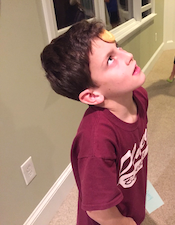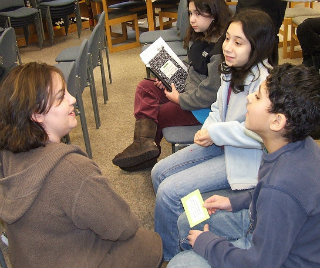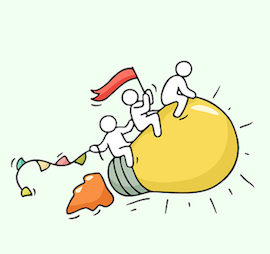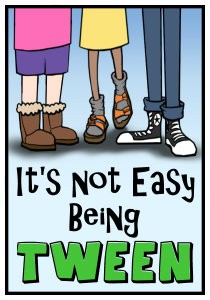Keep Students Engaged Until Summer Begins
A MiddleWeb Blog
In Anna Karenina, Tolstoy wrote, “Spring is the time of plans and projects.” Nowhere is this more evident than in middle school. The students are excited thinking about their summer plans, and the teachers are trying to keep them focused with projects. This situation does not always create harmony.
The key to keeping student minds active is to find the middle ground between (1) the desire to celebrate the end of testing with fluffy, fun activities that have little curricular purpose; and (2) the assignment of a gigantic, soul-crushing project that will require students to work tirelessly for weeks to finish by the end of school.
Lots of letters to finish the year
Like many teachers, I have found great success with the prototypical letter writing assignments. For example, sixth graders love to write to next year’s incoming class, giving them tips on how they adapted and learned to thrive in middle school. Seventh graders write to next year’s incoming class about what it was like to become a true teenager.
Eighth graders write Thank You letters to an adult in the building who has done something exceptionally kind or who has inspired them in some way. Those letters are my favorites. Each year when the students finished, I distributed their letters to the aforementioned adults. Every year, without fail, every adult in the building was represented: proof that we never fully appreciate the extent of our reach or the importance of our role.
Reflecting and goal setting
There are many other reflective and goal-setting activities I’ve used, as do many schools across the country. A few of my favorites are:
- Compliment pages where each child’s name is on a piece of paper that gets passed around the room for peers to write down something wonderful they have noticed about them during the year. Each child keeps his or her page at the end.
- A chart of this year’s “Wins” and “Fails” along with some discussion of growth mindset.
- A comparison between the learning goals they set in September and how much they believe they have progressed.
A letter they write to their “next year” self, setting goals for how to improve. One really fun way to do this is to use futureme.org, and the goal lists will automatically be delivered via email on a specified date in the fall.
- End-of-year surveys about the class or a Teacher Report Card assignment where students are free to constructively express strengths and weaknesses of the instruction.
- Gathering their best work in portfolios.
Students generally enjoy these kinds of activities because they are feeling a bit nostalgic given that nine months is a proportionately long time in their lives. The problem is, nostalgia has a limited shelf life and students eventually want to move beyond just reminiscing. This is where meaningful, curriculum-based projects and activities come into the picture.
Moving beyond nostalgia
Here are some extension activities I have used to end the year on an up beat.

Cookie Face Challenge
1. Stations. Have students practice important skills in a station rotation format. This allows for movement, collaboration, and greater retention. You could add a twist by having the students work in groups to design the learning activity for one of the stations and then rotate through the others. Another option is to populate one or more of the stations with “Minute to Win It” type active games (see for example teachmama.com.)
2. Infographics. Point students toward one of the many software and online programs (such as Canvas or Picktochart) that allow for making lovely infographics about one of the topics they’ve studied this year. Save these to a portfolio that can be used by the next year’s students. Thinglink and Glogster are related programs that can achieve a similar result but create online, interactive visuals.
3. Digital Storytelling. Experimenting with various methods of digital storytelling. One fun version I have enjoyed is having students invent a Superhero and write his or her story. This is a great way to review and apply literary elements. For more fun, explore some of the superhero name generators on the internet. Here’s one.
They have to determine the backstory, super power, antagonist, mission, etc. These can then be developed and presented via digital storytelling apps such as Storybird, Storyboard That, or Storify.
4. Inference. In English class learning to infer what is not said in the text is a crucial skill. This can be practiced in many ways such as using a painting or photo from a particular time or event and having students make and defend educated guesses about what is happening.
One really fun way I have used this is with Norman Rockwell paintings. He had an incredible knack for telling an entire story in one frame and students love exploring his work. Wordless picture books serve a similar purpose.
5. Virtual Field Trip. During the school year, I use many virtual field trips to give students a feel for the context of the literature we read. Now, I can turn the tables and have students develop a virtual field trip web page on a topic of their choice.
6. TED-style Talks. Speaking and listening are discrete skills taught in English courses. I show several professional TED talk clips throughout the year, and this is the perfect time for students to share their passion or expertise with their peers. Here’s a MiddleWeb article about a TED Talk project.
7. Letters to the Editor. My students write an op-ed piece on a topic of their choice to explore argumentative writing. Why not raise the stakes and have them write a letter about their topic to the editorial page of the local newspaper (make sure you have parental and school permission before submitting) and see where that takes them?
8. Dear Abby-style Letters. The best way to get better at writing is to write. To that end, I like to provide as many low-stakes, enjoyable writing opportunities as possible. For this project, students submit an anonymous problem to the resident advice columnists – their peers. (You may want to read the problems first to avoid any issues.) Distribute these the next day to their peers from another class period and charge them with writing a thoughtful response with sound advice.
9. Class Newspaper. Working alone or in groups, students work to make a newspaper containing all of the main events/highlights of the school year. Distribute the result schoolwide at the end of the year.
10. Book Commercials. We practice argumentative writing and persuasive rhetoric rather extensively. We also become a reading community that shares our love of the page with one another. I combine both of these to have students write and perform a commercial selling a book they choose to peers (encouraging them to read the book). I compile a list of these and share with students to assist them in making their summer “To Be Read” list.

Really ambitious students may even want to make their own or play some of the free games online. I also enjoy the non-digital STEM type projects that require a great deal of communication such as Save Fred (get a gummy worm into a plastic cup using paper clips as fingers). There are myriad projects on the internet that have been developed since everyone first used the spaghetti and marshmallow tower activity.
12. Passion Projects. Although my students do these earlier in the year, this is the perfect time to explore Genius Hour and other self-directed inquiry projects.
Keep them busy to the end



 A letter they write to their “next year” self, setting goals for how to improve. One really fun way to do this is to use
A letter they write to their “next year” self, setting goals for how to improve. One really fun way to do this is to use 



































Great article. I shared this with my children who are in the education field. Thank you.
Cheryl–
Thank you for this good summary! I also have 20 plus years at the middle level, this is giving me some good ideas.
Thank you. I am so happy it was useful.
I am new to teaching Middle School and this was very informative! I am going to implement some of these suggestions.